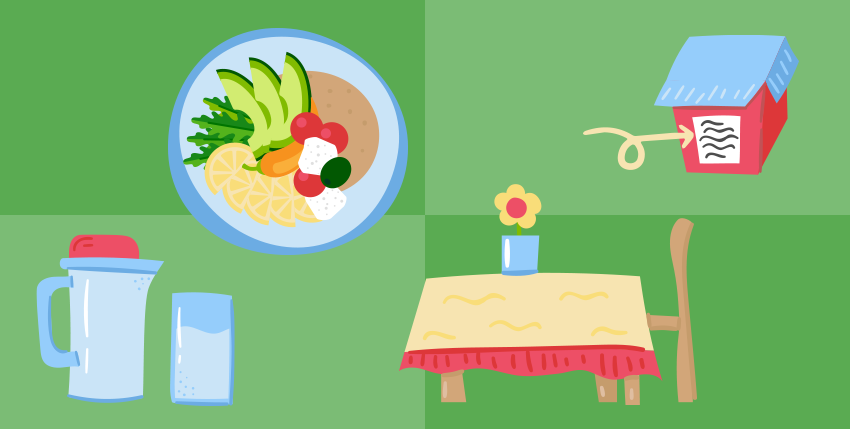In recognition of National Nutrition Month, Purely Inspired will be featuring stories this March that will coincide with the Academy of Nutrition and Dietetics annual campaign that invites people to learn about making informed choices and developing healthful eating and physical activity habits.
Here at Purely Inspired, we want to empower you to ‘Do What Makes You Feel Good.’ That’s why we’re in complete agreement with the Academy of Nutrition and Dietetics that there is no one-size-fits-all approach to nutrition and health. We are all unique with different bodies, goals, backgrounds, and tastes, and our individual health and nutrition journeys should reflect that truth.
For those of you who are eager to start your healthy eating journey this month, we’ll be cheering you on every step of the way. We know that it’s the first small step that can sometimes be the hardest, but once you get going, we’re confident that you’ll be celebrating your simple wins in no time, and enjoying your guilty pleasures guilt-free once again.
HOW TO GET STARTED ON YOUR HEALTH AND NUTRITION JOURNEY
If you get overwhelmed just thinking about the foods you should and shouldn’t be eating, we’re with you. There is just so much conflicting information out there. One day there’s an article about a study that says eating a bit of chocolate once a week could be good for you, and then the next day there’s an article that reports that the scientific evidence remains pretty slim that chocolate has any benefits. Then to just completely complicate and confuse matters even further, we learn that several studies have found mixed results.So, for those of us who just want to know: is chocolate good for us? We’ve done our research, but we still have no clue. That’s why taking that first step on our health and nutrition journey can be so difficult.
But it’s exactly for that reason that we should take that first step and get started with our health and nutrition journey today. Instead of reading about what may or may not work, let’s do some firsthand trial and error and find out which foods make us feel good, and which ones don’t. Since everyone is different, there will be no one right or wrong answer. What works for you may not work for your best friend, and vice versa. And that’s OK. In fact, that’s the beauty of this journey. It’s calling and inviting us to become the best version of ourselves, and the only way we can accomplish that is if by listening to our intuition and trusting our instincts.
Our healthy eating journey isn’t about perfection. It’s about progress. And the only way we’ll see any progress is if we get started. So, here are four tips on eating healthy to get us going.
4 TIPS ON EATING HEALTHY
Tip #1: Eat A Variety Of Nutritious Foods Every Day
The Academy of Nutrition and Dietetics recommends eating a variety of nutritious foods every day, while making sure to include healthful foods from all five food groups. The five food groups are Fruits, Vegetables, Grains, Protein Foods, and Dairy.
The food groups can also be broken down into subgroups. Whole fruit and fruit juice are fruit subgroups. Dark green vegetables, red and orange vegetables, beans, peas, and starchy vegetables are vegetable subgroups. Whole grains and refined grains are grain subgroups. Seafood, meat, poultry, eggs, nuts, seeds, and soy are subgroups of protein foods. And milk, yogurt, and cheese are dairy subgroups.
While oils are not a food group, they are considered part of a healthy eating pattern because they are a major source of essential fatty acids and vitamin E. The American Heart Association also recommends reading nutrition facts labels carefully, and limiting saturated fat, trans fat, sodium, red meat, sweets, and sugary drinks.
Tip #2: Learn How To Read Nutrition Facts Panels
The Academy of Nutrition and Dietetics features a quick guide to reading the Nutrition Facts label. The first step is to start with the serving size. You’ll find both the serving size, which is the amount people usually eat at one time, as well as the number of servings in the package. Make sure to compare your portion size, or the actual amount you’re eating, to the serving size listed on the panel. For example, if the serving size is one cup and you’re eating two cups, then you’re eating twice the calories, fat, and other nutrients than what is listed on the label, according to the Academy of Nutrition and Dietetics.
You’ll also want to find out how many calories (how much energy you get from a serving of food) are in a single serving. You can use the percent Daily Values (DV) as a guide to help evaluate how a certain food fits into your daily meal plan. Keep in mind that the percent DV are for the entire day, not just one meal, and the DV are average levels of nutrients for a person eating 2,000 calories a day.
It’s also important to understand the relative significance of the items listed in the Nutrition Facts. . For example, if a food has 40 calories or less per serving, it is generally considered low calorie (among other requirements), not to be confused with healthy. Look for items in the Nutrition Facts that contain atleast 10 to 19 percent of the DV of a particular vitamin or nutrient per serving.
When evaluating the Nutrition Facts, look for foods that are low in saturated fat, added sugars, and sodium. . Any easy way to add more of these nutrients to your diet is by eating more fruits and vegetables.
Tip #3: Learn To Eat Mindfully
Mindfulness is a practice based on Zen Buddhism that has become popular as a way of self-calming and as a method of changing eating behaviors. Mindfulness encourages people to take care of themselves, and mindful eating allows us to gain awareness of our eating experience.
“Mindful eating (i.e., paying attention to our food, on purpose, moment by moment, without judgment) is an approach to food that focuses on individuals’ sensual awareness of the food and their experience of the food,” according to the American Diabetes Association publication, Diabetes Spectrum. “It has little to do with calories, carbohydrates, fat, or protein. The purpose of mindful eating is not to lose weight, although it is highly likely that those who adopt this style of eating will lose weight. The intention is to help individuals savor the moment and the food and encourage their full presence for the eating experience.”
In order to eat mindfully, the Academy of Nutrition and Dietetics suggests avoiding distractions while eating and taking time to enjoy your food. While it’s difficult to avoid distractions at every meal due to work, family, or a variety of other factors, try to block out at least one meal a day in which you can just focus on the food in front of you. And if one meal a day sounds too hard, start with one meal a week in which you make the time to savor the food, enjoying the taste and texture of each bite, without any distractions.
Tip #4: Hydrate Healthfully
“Water is your body’s principal chemical component and makes up about 50% to 70% of your body weight,” according to Mayo Clinic. “Your body depends on water to survive. Every cell, tissue, and organ in your body needs water to work properly.”
Since you lose water through your breath, perspiration, urine, and bowel movements, you need to replenish your body’s water supply by drinking beverages and eating foods that contain water in order for your body to function properly.
An adequate fluid intake is about 15 ½ cups or 3.7 liters of fluids a day for men and about 11 ½ cups or 2.7 liters a day for women, according to the U.S. National Academies of Sciences, Engineering, and Medicine. About 20% of your daily fluid intake will usually come from food, and the rest from drinks.
You may have also heard the advice to drink eight glasses of water per day. If that works for you, keep doing it. Just keep in mind that you might need to modify your daily fluid intake based on a variety of factors such as exercise, being in hot or humid weather (which can make you sweat), and your overall health – your body loses fluids when you have a fever, vomiting, or diarrhea. So, that’s why it’s a good idea to drink lots of fluids when you’re not feeling well. Most healthy people will be able to stay hydrated by drinking water and other fluids whenever you first feel thirsty.







